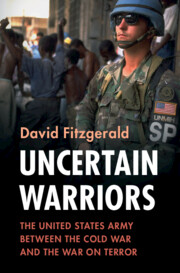Book contents
- Uncertain Warriors
- Military, War, and Society in Modern American History
- Uncertain Warriors
- Copyright page
- Dedication
- Contents
- Figures
- Acknowledgements
- Introduction
- 1 The Post-Vietnam Recovery, Operation Desert Storm and the Veneration of the Volunteer Soldier
- 2 Gender, Sexuality and the Profession of Arms
- 3 Warriors Who Don’t Fight
- 4 Downsizing, Recruiting and Debates over Military Service
- 5 Technological Transformation and the American Soldier
- 6 The Warrior Ethos
- Epilogue
- Index
5 - Technological Transformation and the American Soldier
Published online by Cambridge University Press: 19 October 2023
- Uncertain Warriors
- Military, War, and Society in Modern American History
- Uncertain Warriors
- Copyright page
- Dedication
- Contents
- Figures
- Acknowledgements
- Introduction
- 1 The Post-Vietnam Recovery, Operation Desert Storm and the Veneration of the Volunteer Soldier
- 2 Gender, Sexuality and the Profession of Arms
- 3 Warriors Who Don’t Fight
- 4 Downsizing, Recruiting and Debates over Military Service
- 5 Technological Transformation and the American Soldier
- 6 The Warrior Ethos
- Epilogue
- Index
Summary
As the Army reflected on the lessons of the Gulf War, it worried about the challenges it had faced in that war. First, the full build-up of forces had taken months, and time was a luxury the Army might not have again. Second, the triumph of precision airpower seemed to herald the arrival of the Revolution in Military Affairs that threatened to relegate ground troops to supporting roles. To help meet these challenges, Army leaders embraced the concept of ‘transformation’. With it, they pushed the Army towards a lighter, more deployable force, emphasising an ‘expeditionary culture’, and began the process of restructuring the Army around modular brigades rather than the larger, less deployable division. These brigades would be heavily reliant on lighter, faster, wheeled Stryker armed fighting vehicles, advanced communications equipment and precision weapons, and would be rapidly deployable to crisis points. Ironically, these new ‘expeditionary’ units would be heavily reliant on the support of civilian contractors, who took on increasing amounts of logistical and maintenance work within the transformed Army.
Keywords
- Type
- Chapter
- Information
- Uncertain WarriorsThe United States Army between the Cold War and the War on Terror, pp. 179 - 215Publisher: Cambridge University PressPrint publication year: 2023

